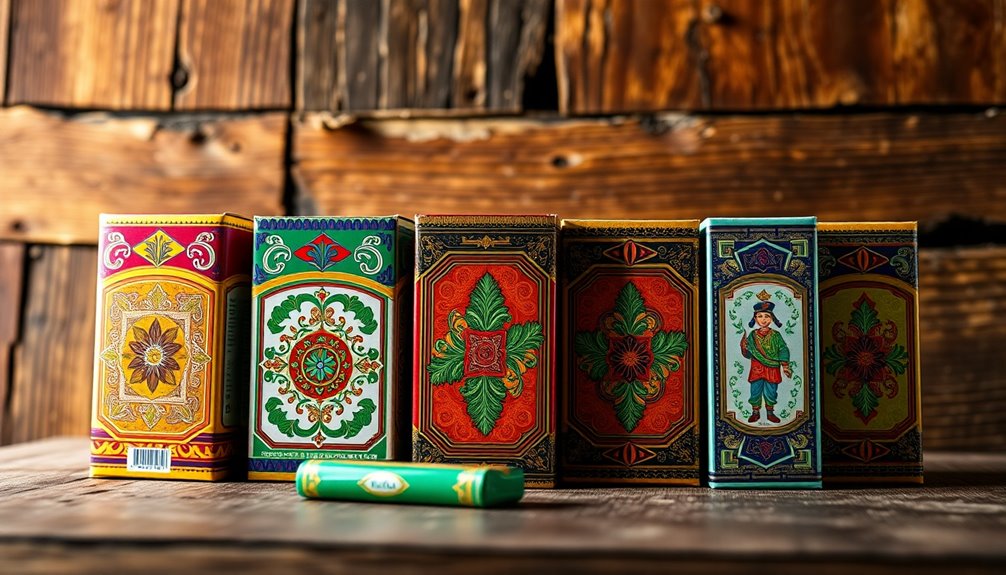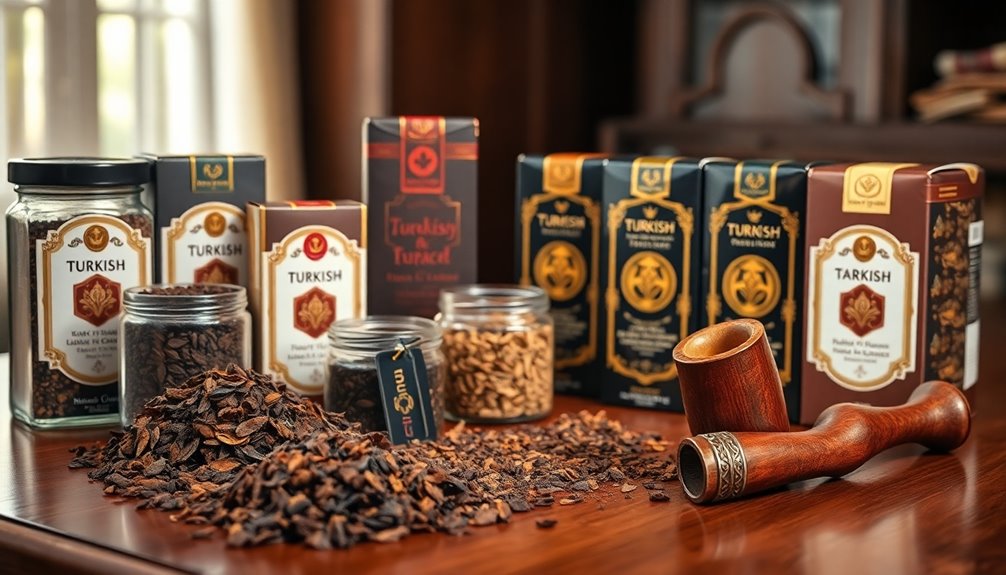Pipe tobacco varietals are distinguished by their curing methods, flavoring techniques, and blending styles. For example, air-cured tobaccos develop sweet, aromatic qualities, while fire-cured varieties deliver smoky, bold flavors. Flavored additives like vanilla or whiskey can be incorporated for more sweetness or depth. These factors shape each blend’s aroma and taste, giving you a wide range of experiences. Exploring how different curing and flavoring techniques work helps you find the perfect pipe tobacco—there’s much more to uncover behind each style.
Key Takeaways
- Different curing methods (air, fire, flue) influence tobacco flavor, texture, and aroma.
- Air curing produces sweet, aromatic Virginia and Oriental blends.
- Fire curing imparts smoky, robust flavors, common in Balkan and English blends.
- Flue curing creates bright Virginia with sweet and tangy notes.
- Additives like vanilla or whiskey enhance natural flavors, creating unique profile varieties.

Have you ever wondered how different pipe tobacco varietals can influence your smoking experience? It all begins with the way the tobacco is processed and prepared, especially through various tobacco curing methods and the use of flavoring additives. These steps are critical in shaping the final flavor profile, aroma, and overall enjoyment of your pipe tobacco.
Discover how curing methods and flavor additives shape your pipe tobacco experience.
Tobacco curing methods play a essential role in determining the characteristics of each varietal. For example, air curing involves hanging the tobacco leaves in a well-ventilated space, allowing them to dry slowly and develop mellow, nuanced flavors. This method is often used for Oriental and Virginia tobaccos, creating a sweet, light, and aromatic base. Conversely, fire curing involves exposing the leaves to smoke from smoldering fires, imparting a smoky, robust flavor—common in certain Balkan and English blends. Flue curing, which uses controlled heat and humidity, produces bright Virginia tobaccos with a naturally sweet and tangy taste. Each curing process influences the tobacco’s texture, moisture content, and flavor development, giving each varietal its distinctive character. Additionally, the choice of curing method can impact the tobacco’s aroma and how it burns, further affecting the overall smoking experience.
Flavoring additives further expand the diversity of pipe tobacco. You might notice some blends with hints of vanilla, cherry, honey, or whiskey, which are added to enhance or complement the natural tobacco flavors. These additives can be incorporated during the curing process or blended into the tobacco afterward, allowing manufacturers to craft a wide range of taste experiences. For example, aromatic blends often contain flavoring additives that create a sweet, fragrant smoke, perfect for those who prefer a more flavorful experience. On the other hand, straightforward Virginia or Balkan blends focus on the pure, natural qualities of the cured tobacco, with minimal or no added flavors.
The combination of curing methods and flavoring additives defines each pipe tobacco varietal, making it unique. If you like a smoky, intense experience, you might prefer a fire-cured blend with added whiskey flavoring. For a lighter, more natural taste, an air-cured Virginia without any flavoring might suit you better. Understanding how these factors influence your tobacco helps you choose blends that match your preferences and enhances your overall enjoyment. Ultimately, exploring these differences allows you to appreciate the craftsmanship behind each blend and find the perfect match for your palate. So, next time you pick out a pipe tobacco, consider how its curing process and flavoring additives contribute to the flavor profile you’ll experience with each puff. Recognizing the influence of curing and flavoring can deepen your appreciation for the art of pipe tobacco blending.
Frequently Asked Questions
How Do I Choose the Right Tobacco Varietal for My Pipe?
To choose the right tobacco varietal for your pipe, consider your preferred flavor profiles and how tobacco blending influences taste. Try different blends to discover what suits you best—whether you like mild, aromatic, or robust flavors. Experimenting helps you find your perfect match, so don’t be afraid to explore various varietals and blends until you find one that enhances your smoking experience.
Are There Health Differences Between Tobacco Varietals?
Like a symphony where each instrument’s tone varies, tobacco varietals differ in health implications and addiction potential. Some may pose greater risks due to nicotine levels, affecting your health more intensely. While all tobacco carries inherent health concerns, selecting varietals with lower nicotine content can mitigate addiction potential. Remember, regardless of the blend, moderation is your best conductor to enjoy your pipe without risking your well-being.
Can Varietals Affect the Smoking Experience?
Yes, varietals can substantially affect your smoking experience. Different tobacco types offer unique flavor profiles, from sweet and spicy to earthy and robust, shaping your taste journey. They also influence aroma enhancement, making each smoke more or less fragrant. By choosing specific varietals, you can customize your experience, enjoying richer flavors and aromas that suit your preferences, ultimately making every puff more enjoyable and tailored to your palate.
How Should I Store Different Tobacco Varietals?
Imagine you’ve just bought a rare Virginia tobacco blend. To keep it fresh, store it in a airtight container designed for tobacco, ensuring humidity control between 60-70%. Avoid direct sunlight and temperature fluctuations. For ideal preservation, use wooden or ceramic storage containers, which regulate moisture better than plastic. This way, your tobacco stays flavorful and ready whenever you want to enjoy a smooth smoke.
Do Certain Varietals Require Specific Preparation Methods?
Yes, some tobacco varietals do require specific preparation methods to enhance their flavor profiles and improve cigar pairing. For instance, Virginias are often cured to highlight their sweetness, while Latakia’s smoky character benefits from gentle handling. By tailoring your prep, you can better match your tobacco with complementary flavors, ensuring a richer smoking experience and more harmonious flavor profiles. Adjusting preparation techniques helps you get the most out of each varietal.
Conclusion
Now that you understand the different pipe tobacco varietals, you can appreciate their unique flavors, aromas, and histories. You can choose with confidence, explore with curiosity, and savor with satisfaction. You can experiment with blends, refine your preferences, and deepen your appreciation. Ultimately, you can enjoy the journey, embrace the diversity, and find the perfect varietal that speaks to your palate. Your pipe tobacco experience becomes richer, more meaningful, and truly personalized.










